*This article may contain product links which pay me a small commission if you make a purchase. Learn more.
Where should a coach position his infield for the best possible defense given the situation? What are the basic baseball infield positions that should be taught in youth baseball? How should players shift given a hitter’s handedness?
In this guide to baseball infield defenses, we’ll cover both simple and advanced shifts and strategies:
- Standard infield depth
- Infield “in”
- Infield Halfway (a rarely used one)
- Shifting
- Many more types of defenses
Skip ahead anywhere in the article using the table of contents below.
- For Reference: Player Position Numbers
- Basic Baseball Infield Defenses
- Watch this video for an in-depth explanation
- Standard Infield Depth
- Infield “In” Can Preserve a Victory
- Double Play Depth: Where it Is & Why It’s So Important
- More Advanced Baseball Infield Defenses
- Should Youth Baseball Teams Use The Shift?
- Common Infield Defense Coaching Mistakes
- Mistake #1: Bringing the infield in too early and/or often
- Mistake #2: Failing to utilize the “infield halfway” position
- Mistake #3: Being too rigid about positioning
- Mistake #4: Not shifting on righties vs lefties in non-force situations
- More Baseball Resources
- FAQ – Common Questions About Infield Positioning in Baseball
And if you’re looking for a great pitching resource, check out my book below and subscribe to my baseball YouTube channel.

For the coach looking to increase his baseball IQ, this article and my other resources will be a great start.
For Reference: Player Position Numbers
The positional numbers need to be quickly gone over here, as they’re not taught as often today as in the past. Players used to be more comfortable with a baseball scorebook in their hands, but in 2021 that job is usually done via iPad app in the bleachers by parents using apps like Gamechanger.
- Pitcher (P) is fielder #1
- Catcher (C) is fielder #2
- First Baseman (1B) is fielder #3
- Second Baseman (2B) is fielder #4
- Shortstop (SS) is fielder #6
- Third Baseman (3B) is fielder #5
- Left Fielder (LF) is fielder #7
- Center Fielder (CF) is fielder #8
- Right Fielder (RF) is fielder #9
Basic Baseball Infield Defenses
First, let’s cover basic baseball infield defense – the tried and true handful of team positions that will be used in most situations.
Watch this video for an in-depth explanation
Standard Infield Depth
By “standard” we just mean the way players would be lined up on the field before the hitter even walks into the box. At the highest levels of baseball, there isn’t really any exact way to set up – there will always be some amount of shading (slight movement to one way or another) or shifting depending on factors like:
- The handedness of the hitter
- The speed of the hitter
- The game situation
- The tendency of a hitter to bunt or not
- The tendency of a hitter to hit to one side of the field more than another
Many factors come into play even when playing straight-up like the diagram below, but the standard baseball defense has a few notable things to be aware of:
- The second baseman will play deeper than the shortstop because the throw to first is not nearly as long
- The first baseman will play deeper than the third baseman because he’s so close to the base
- The third baseman has a long throw and most hitters who bunt will try to push it down the third base line, so third baseman will usually start closer to the plate early in the count, then move back if no runners are on base and the hitter is past the point of bunting. Hitters rarely try to bunt after they have 1 or 2 strikes on them, so third baseman generally relax about bunt threats after a strike has been called.
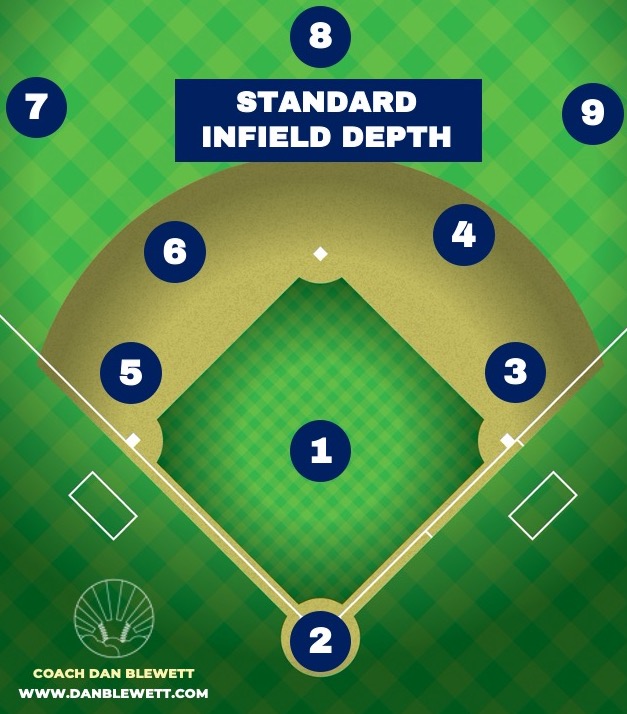
In youth baseball, the field will NOT look exactly like this, especially with young players playing on the full-sized diamond. Because throws are so long for such small players, shortstops and third baseman often play much closer to the plate so they can make these longer throws (compared to the youth-sized diamonds).
Hitters also don’t have as much power and amateur fields have longer grass than pro fields, so batted balls don’t make it as deep on the infield, either, so players have to charge balls more aggressively to have a chance at an out. 14U shortstops can’t wait for a ground ball to take 11 hops to get to them at deep short, so they often play closer –these are things to remember.
Infield “In” Can Preserve a Victory
Bringing the infield in is a do or die play, where in the tying run or go-ahead run is on third base with 0 or 1 out. Any ground ball must be thrown home to prevent this run from scoring, and thus all four infielders are brought in to the edge of the grass.
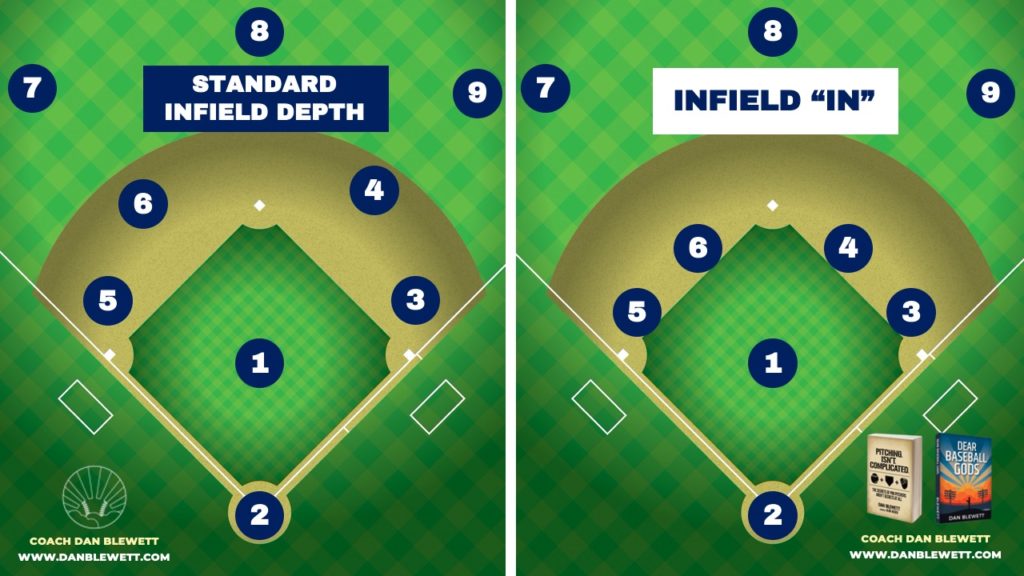
the Infield in situation is one that is often overused where greedy coaches try to prevent a run early in games. The problem with the infield in, however, is that it DRASTICALLY reduces the range of the infielders. Bloopers can land on the infield dirt for base hits in many cases, and medium-hit ground balls often become base hits because the fielders are so close.
The infield-in defense can be used earlier in games, as long as the coach believes:
- That the hitter has a very high probability of hitting a grounder
- That giving up a hit because of reducing infielder range won’t open the flood gates and cause a big inning
- The pitcher can control the game well enough to warrant concern over a single run
In close, pitchers’ duel type games where its clear that one run may win it or lose it, coaches may try to prevent an early run by bringing the infield in early. This can be a smart move, depending.
But in most situations, bringing the infield in done in the late innings when the outcome is clear and just a single run to tie or win must be prevented.
Double Play Depth: Where it Is & Why It’s So Important
What is doubleplay depth? It’s when the shortstop and second baseman stand closer to 2nd base to be prepared to receive a throw quickly on a hard-hit grounder that has a chance to become a double play.
Ground ball double plays occur under the following big conditions:
- They are hard-hit
- They are hit very close to a fielder
If a fielder has to charge a ball for many steps, it will take too long to turn the double play.
And, if a fielder has to run a long distance to field the ground ball, it will also take too long to turn it.
Most double plays happen on hard-hit ground balls that are within only a handful of steps in any direction of a fielder.
Middle Infielders’ Positioning in the Infield
Double plays happen FAST. Because of this, both middle infielders need to be closer to 2nd base than normal, because if a double play has a chance, they have to be able to receive and get rid of the throw as fast as possible.
And since double play balls are hit hard, they have to be able to be at 2nd base within about one second. This means their positioning before the play has to place them about 8 steps from the bag – typically eight over and behind it in a diagonal.
First & Third Baseman: Their Roles in the Double Play
The first baseman will be holding the runner on at first base, and he will move in front of the base line after the pitch is delivered. The third baseman will be even or in front of the third base bag. The positioning of both these fielders also serves an obvious purpose: to get the ground ball fielded and on its way to second base as soon as possible. Playing far back takes up too much time.
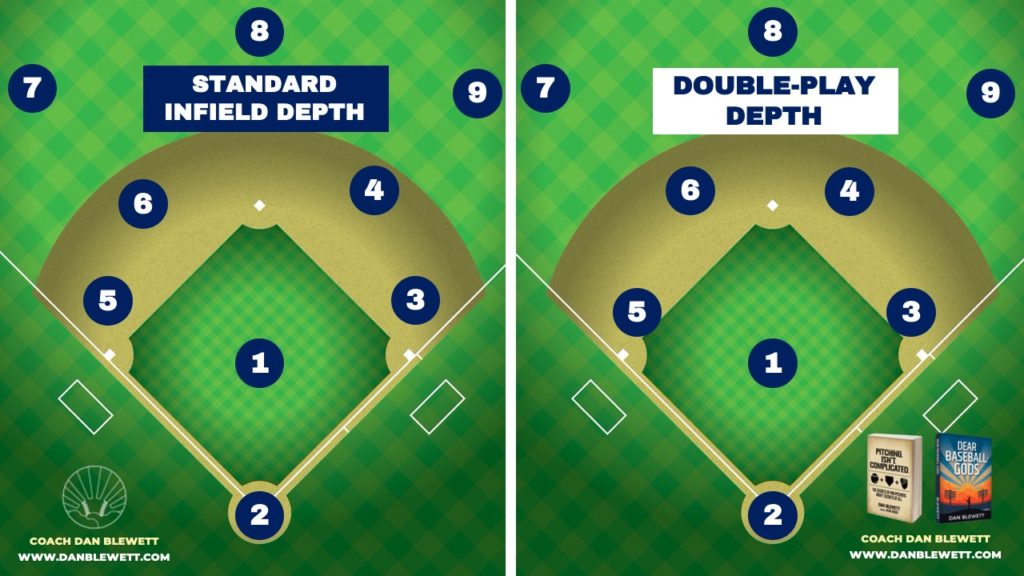
All too often I see youth players (16U and under) playing their normal positioning when the double play is in order. This is a big problem, one that needs to be addressed by their coaches. Doubleplay depth should be a part of practice from a young age and reinforced in games.
More Advanced Baseball Infield Defenses
Many infield positioning decisions are not black-and-white, and the Infield halfway position is a very gray kind of defense.
Infield Halfway – A Gray Area Type of Positioning
Halfway means what it means – the shortstop and second baseman both play in much further than normal, but not so far in they kill their range (as when the infield is fully “in”).
How Infield Halfway is Best Used

Smart coaches bring the infield in halfway when they want to give them two options:
- Get the double play if they can
- Or get the out at the plate if it’s available
When the Halfway Defense Makes Sense
- Runner on 3rd with one out
- First and third when the run is critical
Basically, the infield halfway defense is meant to allow the shortstop or second baseman to use their discretion and go home on a ball hit too softly to become a double play.
OR
It’s used to NOT concede a run in a situation where they otherwise would, such as in the 5th inning with a runner on third with one out. Rather than let the run score on a routine grounder to third, the coach could bring the middle infield in halfway to allow them to throw home if they saw the runner going and believed they had a clear shot to get him.
I’ve seen this work many times and it’s effective at all levels of baseball, and it can catch the offensive team napping – they make think they get a free run with a ground ball to the middle infield, only to have the infielder make the choice to go home.
Slight Shifts in Positioning for 1st & 3rd Basemen
This is not a true shift in the sense of all the players moving in dramatic fashion, but rather a ROUTINE shift that ALL high-level players do on regular basis playing typical odds according to normal hitter tendencies:
- Most hitters will pull the ball much more than they go the opposite way
- It’s very rare that a hitter will hit a ball down the line the opposite way
So, good third baseman have a standard shift away from the line when a lefty is up.
And good first baseman have a standard shift away from the first base line when a righty is up.
How a 3rd Baseman Positions Himself with a Lefty Up
Look at the spray chart overlay (in red) to illustrate a normal distribution of how lefties tend to spray the ball.
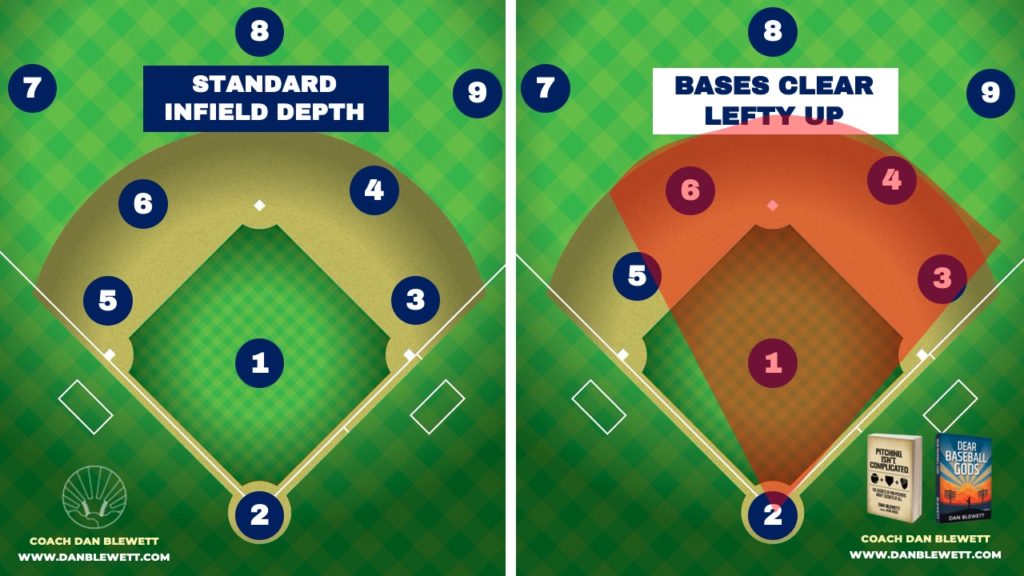
How a 1st Baseman Positions Himself with a Righty Up
The shortstop and second baseman might move a little as well, but typically not very much.
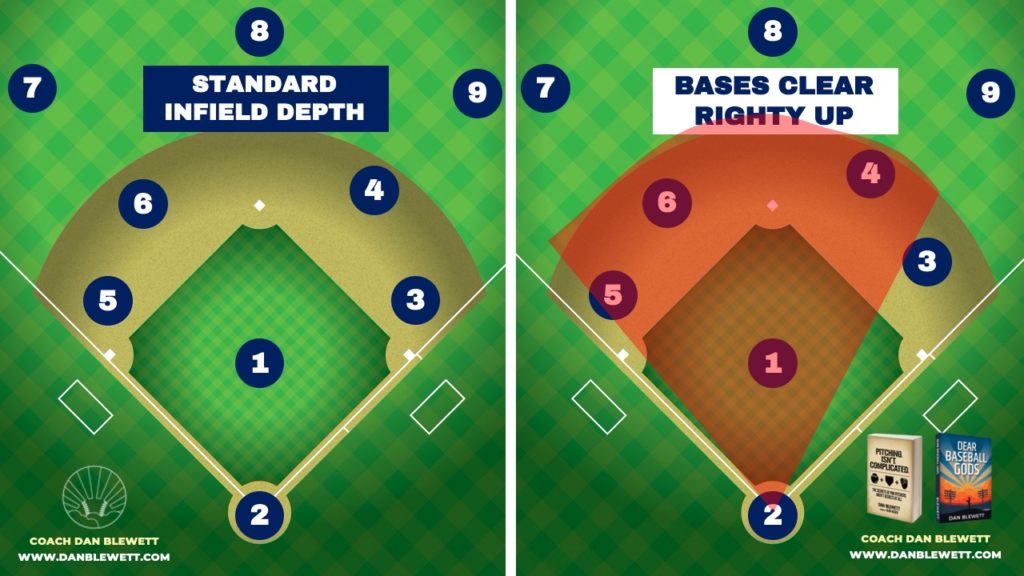
They do this in situations either when the bases are clear or they dont have to cover their home base, hold a runner on or receive a throw on a steal. When the third baseman doesn’t have to hold the bag for any reason and a lefty is up, he’ll move 6-10 feet toward second to play the odds and cover the hole between third and short, conceding more of the line because of how unlikely it is that a lefty will hit a ball down the line the opposite way.
This is normal shifting that all high level players do and VERY few amateurs are taught to do.
Teach this to your players! It’s an easy but important way to prevent a few extra hits each month.
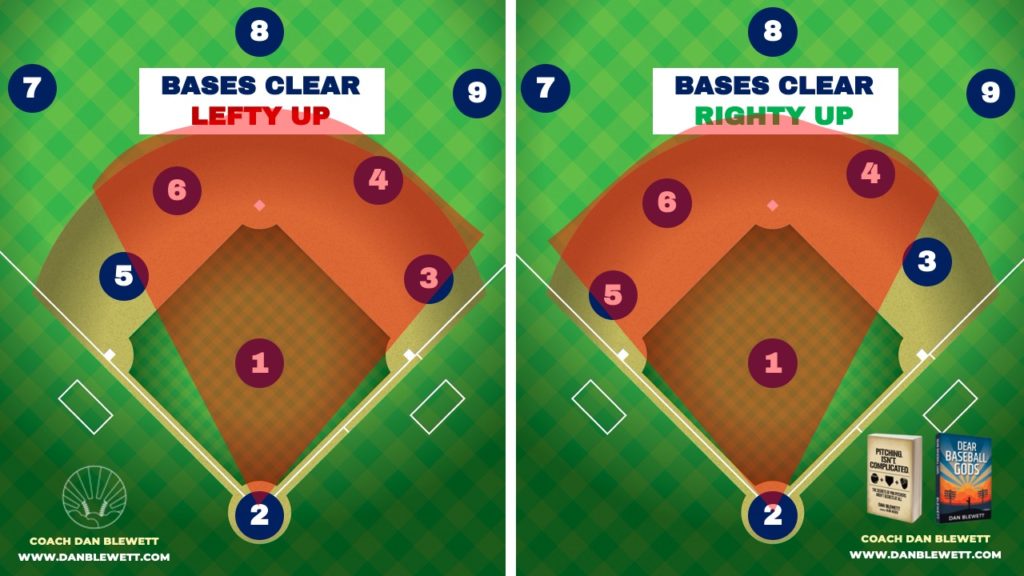
Should Youth Baseball Teams Use The Shift?
And when should teams shift their infielders and outfielders? Is one at-bat, or one game’s worth of data enough?
Learn the answers in this video below about why small samples in baseball are NOT good indicators of what to do.
Common Infield Defense Coaching Mistakes
Lots of amateur coaches drop the ball when changing their infield positioning. Here are a few common mistakes.
Mistake #1: Bringing the infield in too early and/or often
Remember: bringing the infield in may seem like a great way to prevent a run early in the game, but it gives infielders so little time to react that it turns LOTS of otherwise easy outs into base hits. This effectively can open the flood gates and keep an inning going.
Bringing the infield in can work in some situations and/or be low risk at times early in the game, but many coaches hurt their teams by using it too much.
Mistake #2: Failing to utilize the “infield halfway” position
You don’t always have to concede a run with a runner on 3rd and 0 or 1 outs.
You also don’t have to bring the infield all the way in to prevent this conceded run.
The infield halfway position can be very effective with two smart middle infielders who know their arm strength and can make a decision in real-time as to whether to go home, to second or to first. If they can do this, halfway can work.
Mistake #3: Being too rigid about positioning
Positioning in the infield in baseball takes a lot of skill and situational awareness – it’s not something to be overly rigid about because at different ages players have different skills and their positioning needs to reflect their range, arm strength and more.
Don’t put a player in the wrong position just because it’s traditional place for a player to set up. Sure, the standard locations exist for a reason, but as players grow their abilities change rapidly.
Mistake #4: Not shifting on righties vs lefties in non-force situations
This is a no-brainer: players–especially corner infielders–need to shift slightly to play the odds where appropriate.
More Baseball Resources
I hope this article on the many simple and advances infield positions in baseball was helpful to you. Check our more of my resources below for more helpful guides.
- Subscribe to my YouTube Channel
- My Detailed Article on Baseball Positions
- Read My Article on Pitching Mechanics
- My Article on How to Throw a Curveball
- My Article on How to Throw a Changeup
- Read all About Balks – The Rules & How to Avoid Them
And, grab a copy of my pitching book below.

FAQ – Common Questions About Infield Positioning in Baseball
What is double play depth?
Double play depth is when the shortstop and second baseman stand closer to 2nd base to be prepared to receive a throw quickly on a hard-hit grounder that has a chance to become a double-play. Typically this is 8 steps back and 8 steps over.
Why is the infield in position not used all the time?
It dramatically cuts down on the range of infielders and allows otherwise easily fielded ground balls and bloopers to fall through and become hits.
